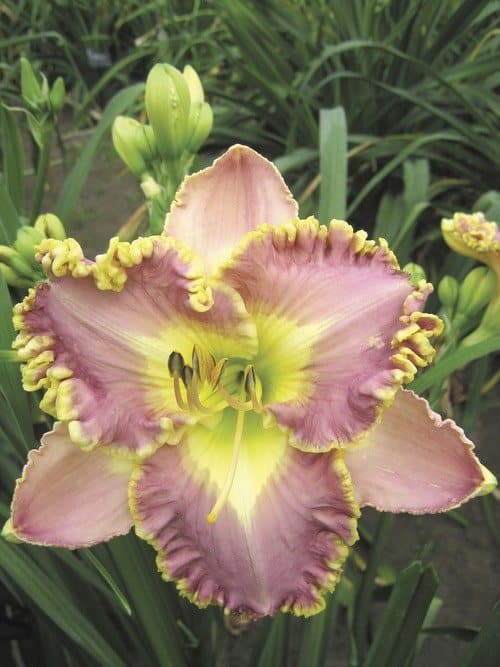
If you like innovative flower forms, it’s worth taking a look at the new daylily hybrids offered each year. They’re bolder than ever — either plant hybridizers are shaking off traditional constraints or gardeners are demanding more gilding on the lilies. ‘Lavender Tutu’, bred in 2011, is one that caught my eye, and goes on my order list for spring (veseys.com). It has a ruffled pie-crust edging, but still looks like a daylily; it hasn’t been disguised as, perhaps, a dahlia or a peony.
Daylilies are obliging plants when it comes to breeding new characteristics into their flowers. Even a backyard gardener can make simple pollen crosses and produce dozens of new daylily designs, one of which might just be a winner (then again, many might have muddy colours). And, of course, breeding your own new seedlings means you can name them after yourself!
‘Lavender Tutu’ is a triploid daylily with 44 chromosomes, unlike a diploid, which has 22. The higher chromosome count results in sturdy plants with thicker stems and larger flowers. Diploids have smaller flowers, but a greater bud count on each stem (also called a scape). ‘Lavender Tutu’ is a rebloomer, with the first flush of blooms in midsummer on 24- to 26-inch (60- to 66-cm) stems, followed by a rest period, then another blooming cycle in late summer. The first flush of flowers yields 26 to 30 buds from one plant. Comparatively, a diploid daylily might carry up to 40 buds.
‘Lavender Tutu’ is a single flower, with three inner petals carefully arranged to symmetrically overlap three outer sepals; sometimes all six segments are referred to as tepals. Double daylilies have more tepals, and their arrangement can be an ordered pattern or more disorganized.
‘Lavender Tutu’ displays one of the most sought after breeding characteristics in daylilies: a deeply crimped and ruffled edge on the three inner tepals. The crimping is so extreme that it looks like the deep flounces of a ballerina’s tutu. And what’s more, the tutu is a contrasting bright yellow against the lavender tepals. (I wonder how many years of breeding work went into that tutu?) Further back in the flower is a golden halo, leading into a green-gold throat.
This flower touches several of the bases popular in current daylily hybridizing. With more focus, and possibly a few more decades of work, additional features could include a watermark (dark staining surrounding the halo area) and additional crimping on the three outer tepals.
As if adding crimped edges, halos, watermarks and throat colours weren’t enough to occupy the time of daylily breeders, increasing the number of petals also comes into the mix. However, extra petals can sometimes make a daylily appeared confused. ‘Exploded Pumpkin’ (veseys.com) is one example of a double daylily that’s on its way to looking like a carnation. Its pumpkin-peach tepals feature gentle ruffling along maroon edges that bleed into a dark watermark. The additional petals rise from the flower’s centre, obscuring the throat, and appear to explode upward. To my mind, ‘Exploded Pumpkin’ could look like quite a messy pumpkin. But have a look and see what you think.









This article states that ‘Lavender Tutu’ is a triploid, with 44 chromosomes. It is actually a tetraploid, as it has 4 sets of chromosomes (double the 22 chromosomes of diploid daylilies). A triploid would have 3 sets–33 chromosomes.